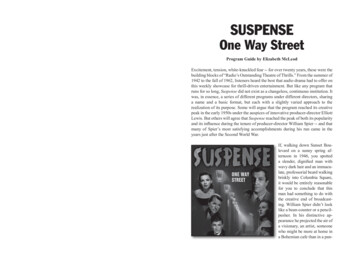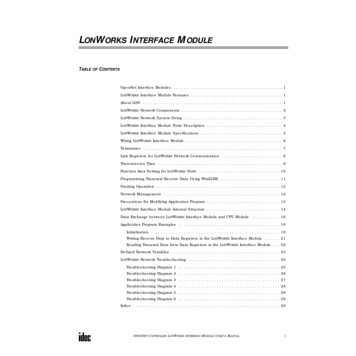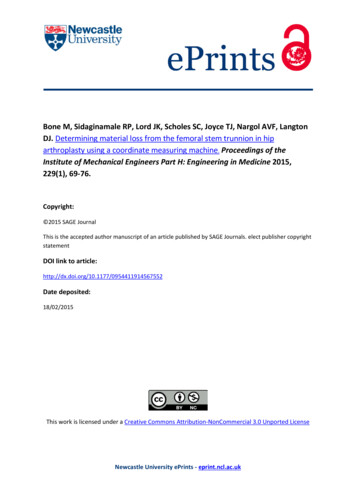
Transcription
SUSPENSECD 10A: “End of the Road” - 02/06/1947A sleazy car salesman steals a rich man’s wife-- and that’s just the beginning of his problems.Glenn Ford and Cathy Lewis are heard in thisbroadcast, written by Robert L. Richards andIrving Moore.One Way StreetProgram Guide by Elizabeth McLeodCD 10B: “Always Room At The Top”Anne Baxter- 02/20/47Anne Baxter, Cathy Lewis, Wally Maher, and Jack Webbstar in this Eleanor Beeson story about an advertising agencystaffed by the vicious and ambitious.Jack WebbElizabeth McLeod is a journalist, author, and broadcast historian. Shereceived the 2005 Ray Stanich Award for excellence in broadcasting historyresearch from the Friends Of Old Time Radio.www.RadioSpirits.comPO Box 1315, Little Falls, NJ 07424 2020 RSPT LLC. All rights reserved. For home use only.Unauthorized duplication prohibited.Program Guide 2020 Elizabeth McLeod and RSPT LLC. All Rights Reserved.48752Excitement, tension, white-knuckled fear -- for over twenty years, these were thebuilding blocks of “Radio’s Outstanding Theatre of Thrills.” From the summer of1942 to the fall of 1962, listeners heard the best that audio drama had to offer onthis weekly showcase for thrill-driven entertainment. But like any program thatruns for so long, Suspense did not exist as a changeless, continuous institution. Itwas, in essence, a series of different programs under different directors, sharinga name and a basic format, but each with a slightly varied approach to therealization of its purpose. Some will argue that the program reached its creativepeak in the early 1950s under the auspices of innovative producer-director ElliottLewis. But others will agree that Suspense reached the peak of both its popularityand its influence during the tenure of producer-director William Spier -- and thatmany of Spier’s most satisfying accomplishments during his run came in theyears just after the Second World War.If, walking down Sunset Boulevard on a sunny spring afternoon in 1946, you spotteda slender, dignified man withwavy dark hair and an immaculate, professorial beard walkingbriskly into Columbia Square,it would be entirely reasonablefor you to conclude that thisman had something to do withthe creative end of broadcasting. William Spier didn’t looklike a bean-counter or a pencilpusher. In his distinctive appearance he projected the air ofa visionary, an artist, someonewho might be more at home ina Bohemian cafe than in a pan-
eled office. So you might be surprised to learn that William Spier started out asa music critic, rubbing shoulders with the elite of the concert world. He was aman fully at home in the refined world of the symphony and the opera, a protégéof renowned author-critic Deems Taylor. And you might be entirely nonplussedto learn that he was only a teenager when he began that early career. Doubtlessmany of his interview subjects were. The cultivation of his famous facial hairnot only lent him an air of dignity, it also helped to conceal his startling youth.died! Brian Donlevy, Cathy Lewis, and Hans Conreid are heard in this episodewritten by J. M. Speed and adapted for by Robert L. Richards.In 1929, at the venerable age of twenty-three, William Spier and his whiskerswent to work at Batten, Barton, Durstine & Osborne. An advertising firm whosename sounded, according to Fred Allen, like a steamer trunk falling down fourflights of stairs, might not have seemed quite the place for an artistic youngman of Mr. Spier’s type. However, it was that agency’s involvement in classical and concert music that brought him there. B-B-D-and-O, as it was knownaround Madison Avenue, packaged and produced The Atwater Kent Hour, anNBC feature presenting the cream of concert and opera talent. Spier, with hisdeep background in the field, was an ideal fit as agency producer. And the youngman found, over the course of his new duties, that he enjoyed radio a great deal.CD 7B: “Drive-In” - 11/21/1946Judy Garland headlines this thriller about a restaurant carhop who becomes thetarget of a murderer. Elliott Lewis and Cathy Lewis co-star in this story by MelDinelli and Muriel Roy Bolton.As an agency man, Spier found himself working on a wide variety of programtypes. One of the most unique of these series began at CBS in 1931 -- a featurethat might be described as a highly specialized variation of the popular themedanthology format. Overseen and sponsored by Time magazine, The March ofTime offered a dramatized look at current events. Actors would impersonateprominent personalities of the day in scenes offering an embellished, entertaining version of each week’s news. As director,Spier assembled a notable cast of versatilecharacter actors drawn (for the most part) fromBroadway. This group included such rising personalities as Agnes Moorehead, Everett Sloane,Paul Stewart, Ray Collins, Martin Gabel anda young man from Wisconsin who combinedpreternatural talent with limitless self-importance to a degree never before encountered in aradio studio. William Spier would remember allof these performers, especially that baby-facedkid genius called Orson Welles.William SpierThe March of Time, with its ever-changing settings, demanded rigorous attention to technical2CD 7A: “Easy Money” - 11/07/1946Jack Carson, Paul Frees, and Cathy Lewis star in this broadcast about a wealthywoman, a desperate man and a talking bird. The script was written by SidneyRenthal.CD 8A: “The House in Cypress Canyon” - 12/05/1946A couple moving into a new home is stalked by an unspeakable terror. RobertTaylor and Cathy Lewis are featured in this episode, written by Robert L.Richards. (Howard Duff makes a special guest appearance as Sam Spade.)CD 8B: “They Call Me Patrice”- 12/12/1946A woman who takes advantage of anopportunity to assume a new identityfinds herself the victim of blackmail.Susan Peters and William Johnstoneare heard in this broadcast. WilliamSpier adapted this Cornell Woolrichtale for radio.CD 9A: “The Thing in the Window”- 12/19/1946Joseph Cotten and Cathy Lewis star inthis Lucille Fletcher story about a manwho sees a dead body in an apartmentwindow. Why can’t anyone else see it?Judy GarlandCD 9B: “One Way Street” - 01/23/1947A slum youth in postwar London looks for a way out.Roddy McDowall and Jeanette Nolan are featuredin this episode, written by Robert L. Richards andSanford Schlessinger.7Joseph Cotten
CD 3A: “The Great Horrell” - 08/22/1946The wife of an oppressive mind-reader tries to break free of his grasp. JoanLorring and Herb Butterfield star in this episode, written by George and GertrudeFass.CD 3B: “You’ll Never See Me Again” - 09/05/1946Robert Young and Cathy Lewis are heard in this broadcast about a newlywedquarrel that turns into a baffling mystery. This Cornell Woollrich tale was adaptedfor radio by William Spier.CD 4A: “Hunting Trip” - 09/12/1946Two men go on a trip to the woods -- will they both return home alive? VincentPrice and Lloyd Nolan are featured in this story by Paul Bernard and Lee Horton.CD 4B: “Till the Day I Die” - 09/19/1946A murderer and his victim share the same face in this thriller by Robert L.Richards and Martin Ryeson. Starring in this broadcast are Dane Clark and CathyLewis.CD 5A: “Three Times Murder” - 10/03/1946The widow of an executed prisoner clashes with theprosecutor who sent him to the chair. Rita Hayworthand Hans Conreid are heard in this episode, writtenby by John deWitt and Robert L. Richards.CD 5B: “A Plane Case of Murder” - 10/10/1946A love triangle leads to an airborne murder plot.John Lund, William Johnsone, and Cathy Lewisare featured in this tale by Robert L.Richards.Vincent PriceCD 6A: “Dame Fortune” - 10/24/1946A blackmail victim decides to turn thetables on her tormentor. Susan Haywardand William Johnstone star in this storyby Max Wilk and Ed Murkland.CD 6B: “Lazarus Walks” - 10/31/1946A man returns from the dead and heisn’t the same man he was when heRita Hayworth6detail. It was the greatest proving ground a radio director could ever experience,and William Spier emerged from that program a seasoned pro with a flossynew position on the CBS staff. Management called him “Director of Development,” sat him down in an office, gave him a list of unsold time slots, and toldhim to get busy coming up with new unsponsored program concepts with whichto fill them. Spier liked this just fine. His years at the March of Time had nevertaken him far from the watchful gaze of Henry Luce and his various minions and now CBS had just given him the keys to the playroom and carte blanche todo anything the broadcast censors would allow.Spier’s pet project in the summer of 1940 was called Forecast, a catch-all titleallowing on-air tryouts for many of the nifty concepts he’d cooked up (or hadcaused others to cook up). And it was on an episode of this series, on the 22ndof July, 1940, that listeners got their first taste of Suspense. The proposed thrilleranthology avoided the kid-oriented hokum that had plagued much of the genreduring the 1930s. Indeed, Suspense would take advantage of methods developedby the Columbia Workshop to create an electrifying feature with an adult sensibility. Its sample episode, featuring a deft adaptation of Alfred Hitchcock’s silentfilm classic The Lodger, drew positive notices. The claim that Hitchcock himselfhad directed the broadcast was a publicist’s sham, and CBS passed on the idea ofa regular series.Passed, that is, until 1942. With an unsold summer time slot to fill, the networkpicked up the program and, with no fanfare at all, tossed it on the air that July. Spier wasn’t involved in the earliest broadcasts, but within a month he’d taken overand shaped the bare concept into the form it would hold for the next twenty years.The emphasis was on real-world tension, on stories of things that could happento ordinary people who were suddenly thrust into extraordinary circumstances.Spier had no firm rule against dealing with supernatural stories -- but if they wereused, they had to be presented plausibly, and the characters had to react as actualpeople would react in such situations.Suspense was specifically not a “horrorshow.” There were no monsters, therewas no gore, and there were no broadInner Sanctum style histrionics. Evenwhen Spier added a “mysterious host”figure to introduce the stories in 1943,he had stern-voiced Joseph Kearns givethat role in a steely, serious tone (utterlyfree of Raymond-ish camp).Alfred Hitchcock3
Spier was just as serious in his selection of story material for the series. Originalstories by top radio talent like Lucille Fletcher were alternated with adaptationsdrawn from the cream of thriller fiction. Such authors as John Dickson Carr andCornell Woolrich were well-represented on Suspense, with careful, thoughtfuladaptations of their best short stories. With scripts in hand, Spier cast his episodes with great care. After the Roma Wine Company (a subsidiary of the Scenery distilling empire) came aboard as sponsor in 1943, Spier had the budget tobring in name talent. However, he always insisted that any movie stars engagedto do his show possess the actual radio acting talent required to do justice to thequality of the material. Not every movie personality had that talent -- and thosewho didn’t, those who saw radio as a chance to pick up some fast cash for noeffort, would never darken William Spier’s microphone. Those who did wereexpected to deliver exacting performances, and for those stars who accepted thechallenge and relished the experience, the door was always open for further appearances.The production values demanded by Spier matched the standard of the performances he expected of his cast. Suspense’s first musical director, Bernard Herrmann, revolutionized the art of scoring for radio drama during the mid-1930s,and his scores for the early years of the program set the tone that would be followed by all subsequent composers and conductors. Lucien Moraweck, WilburHatch, and Lud Gluskin adhered to the Herrmann style of original music, andtheir work added immeasurably to the dramatic power of the broadcasts. Likewise, the sound effects crew headed by CBS-Hollywood technician Berne Surrey expanded the boundaries of what could be done in radio sound work. Spierworked closely with the chief soundman in developing a distinct approach to theeffects in each episode. Surrey’s soundscapes avoided the excesses of “mickeymousing,” the sort of exaggerated effects work that depicted every footstep andevery tick of a clock, and instead used sound to punctuate and emphasize plot points and situations as theydeveloped within the story.Bernard HermannSpier’s tenure on Suspense wound down in the postwar years. (This is because a new series, The Adventures of Sam Spade, claimed an increasing share ofhis time.) He had headed “Radio’s Outstanding Theater of Thrills” for over five years, creating a body ofwork that influenced all of his successors on the series and which stands on its own as one of the mostimpressive resumes in all of audio drama.4The ROMA WINE COMPANYpresentsSUSPENSEProduced and DirectedbyWILLIAM SPIERMusic Composed byLUCIEN MORAWEKMusic Conducted byLUD GLUSKINSound Effects Created and Supervised ByBERNE SURREYCD 1A: “Return Trip” - 06/27/1946Four people are trapped on a bus during a blizzard -- and one of them has adeadly secret. Elliot Reid and Cathy Lewis are featured in this story by MauriceZimm.CD 1B: “An Evening’s Diversion” - 07/04/1946Can a man who accidentally learns of a murder plot stop the killer? This episode,written by Stan Schlessinger, stars Leon Ames, Elliott Lewis, Cathy Lewis, andGerald Mohr.CD 2A: “Photo Finish” - 07/18/1946Roy Grandy and Robert L. Richards wrote this tensetale about a photographer who snaps a murderer inaction. Will this shutterbug become the next victim?Heard in this broadcast are Michael O’Shea, JerryHausner, Cathy Lewis, and Wally Maher.CD 2B: “The Last Letter of Dr. Bronson”- 08/15/1946A doctor facing the slow onset of insanity tries to gethimself murdered. This Leonard St. Clair adaptationof a Richard Krekye story features the voices ofHenry Daniell, Herb Butterfield, and Wally Maher.5Cathy Lewis
Spier was just as serious in his selection of story material for the series. Originalstories by top radio talent like Lucille Fletcher were alternated with adaptationsdrawn from the cream of thriller fiction. Such authors as John Dickson Carr andCornell Woolrich were well-represented on Suspense, with careful, thoughtfuladaptations of their best short stories. With scripts in hand, Spier cast his episodes with great care. After the Roma Wine Company (a subsidiary of the Scenery distilling empire) came aboard as sponsor in 1943, Spier had the budget tobring in name talent. However, he always insisted that any movie stars engagedto do his show possess the actual radio acting talent required to do justice to thequality of the material. Not every movie personality had that talent -- and thosewho didn’t, those who saw radio as a chance to pick up some fast cash for noeffort, would never darken William Spier’s microphone. Those who did wereexpected to deliver exacting performances, and for those stars who accepted thechallenge and relished the experience, the door was always open for further appearances.The production values demanded by Spier matched the standard of the performances he expected of his cast. Suspense’s first musical director, Bernard Herrmann, revolutionized the art of scoring for radio drama during the mid-1930s,and his scores for the early years of the program set the tone that would be followed by all subsequent composers and conductors. Lucien Moraweck, WilburHatch, and Lud Gluskin adhered to the Herrmann style of original music, andtheir work added immeasurably to the dramatic power of the broadcasts. Likewise, the sound effects crew headed by CBS-Hollywood technician Berne Surrey expanded the boundaries of what could be done in radio sound work. Spierworked closely with the chief soundman in developing a distinct approach to theeffects in each episode. Surrey’s soundscapes avoided the excesses of “mickeymousing,” the sort of exaggerated effects work that depicted every footstep andevery tick of a clock, and instead used sound to punctuate and emphasize plot points and situations as theydeveloped within the story.Bernard HermannSpier’s tenure on Suspense wound down in the postwar years. (This is because a new series, The Adventures of Sam Spade, claimed an increasing share ofhis time.) He had headed “Radio’s Outstanding Theater of Thrills” for over five years, creating a body ofwork that influenced all of his successors on the series and which stands on its own as one of the mostimpressive resumes in all of audio drama.4The ROMA WINE COMPANYpresentsSUSPENSEProduced and DirectedbyWILLIAM SPIERMusic Composed byLUCIEN MORAWEKMusic Conducted byLUD GLUSKINSound Effects Created and Supervised ByBERNE SURREYCD 1A: “Return Trip” - 06/27/1946Four people are trapped on a bus during a blizzard -- and one of them has adeadly secret. Elliot Reid and Cathy Lewis are featured in this story by MauriceZimm.CD 1B: “An Evening’s Diversion” - 07/04/1946Can a man who accidentally learns of a murder plot stop the killer? This episode,written by Stan Schlessinger, stars Leon Ames, Elliott Lewis, Cathy Lewis, andGerald Mohr.CD 2A: “Photo Finish” - 07/18/1946Roy Grandy and Robert L. Richards wrote this tensetale about a photographer who snaps a murderer inaction. Will this shutterbug become the next victim?Heard in this broadcast are Michael O’Shea, JerryHausner, Cathy Lewis, and Wally Maher.CD 2B: “The Last Letter of Dr. Bronson”- 08/15/1946A doctor facing the slow onset of insanity tries to gethimself murdered. This Leonard St. Clair adaptationof a Richard Krekye story features the voices ofHenry Daniell, Herb Butterfield, and Wally Maher.5Cathy Lewis
CD 3A: “The Great Horrell” - 08/22/1946The wife of an oppressive mind-reader tries to break free of his grasp. JoanLorring and Herb Butterfield star in this episode, written by George and GertrudeFass.CD 3B: “You’ll Never See Me Again” - 09/05/1946Robert Young and Cathy Lewis are heard in this broadcast about a newlywedquarrel that turns into a baffling mystery. This Cornell Woollrich tale was adaptedfor radio by William Spier.CD 4A: “Hunting Trip” - 09/12/1946Two men go on a trip to the woods -- will they both return home alive? VincentPrice and Lloyd Nolan are featured in this story by Paul Bernard and Lee Horton.CD 4B: “Till the Day I Die” - 09/19/1946A murderer and his victim share the same face in this thriller by Robert L.Richards and Martin Ryeson. Starring in this broadcast are Dane Clark and CathyLewis.CD 5A: “Three Times Murder” - 10/03/1946The widow of an executed prisoner clashes with theprosecutor who sent him to the chair. Rita Hayworthand Hans Conreid are heard in this episode, writtenby by John deWitt and Robert L. Richards.CD 5B: “A Plane Case of Murder” - 10/10/1946A love triangle leads to an airborne murder plot.John Lund, William Johnsone, and Cathy Lewisare featured in this tale by Robert L.Richards.Vincent PriceCD 6A: “Dame Fortune” - 10/24/1946A blackmail victim decides to turn thetables on her tormentor. Susan Haywardand William Johnstone star in this storyby Max Wilk and Ed Murkland.CD 6B: “Lazarus Walks” - 10/31/1946A man returns from the dead and heisn’t the same man he was when heRita Hayworth6detail. It was the greatest proving ground a radio director could ever experience,and William Spier emerged from that program a seasoned pro with a flossynew position on the CBS staff. Management called him “Director of Development,” sat him down in an office, gave him a list of unsold time slots, and toldhim to get busy coming up with new unsponsored program concepts with whichto fill them. Spier liked this just fine. His years at the March of Time had nevertaken him far from the watchful gaze of Henry Luce and his various minions and now CBS had just given him the keys to the playroom and carte blanche todo anything the broadcast censors would allow.Spier’s pet project in the summer of 1940 was called Forecast, a catch-all titleallowing on-air tryouts for many of the nifty concepts he’d cooked up (or hadcaused others to cook up). And it was on an episode of this series, on the 22ndof July, 1940, that listeners got their first taste of Suspense. The proposed thrilleranthology avoided the kid-oriented hokum that had plagued much of the genreduring the 1930s. Indeed, Suspense would take advantage of methods developedby the Columbia Workshop to create an electrifying feature with an adult sensibility. Its sample episode, featuring a deft adaptation of Alfred Hitchcock’s silentfilm classic The Lodger, drew positive notices. The claim that Hitchcock himselfhad directed the broadcast was a publicist’s sham, and CBS passed on the idea ofa regular series.Passed, that is, until 1942. With an unsold summer time slot to fill, the networkpicked up the program and, with no fanfare at all, tossed it on the air that July. Spier wasn’t involved in the earliest broadcasts, but within a month he’d taken overand shaped the bare concept into the form it would hold for the next twenty years.The emphasis was on real-world tension, on stories of things that could happento ordinary people who were suddenly thrust into extraordinary circumstances.Spier had no firm rule against dealing with supernatural stories -- but if they wereused, they had to be presented plausibly, and the characters had to react as actualpeople would react in such situations.Suspense was specifically not a “horrorshow.” There were no monsters, therewas no gore, and there were no broadInner Sanctum style histrionics. Evenwhen Spier added a “mysterious host”figure to introduce the stories in 1943,he had stern-voiced Joseph Kearns givethat role in a steely, serious tone (utterlyfree of Raymond-ish camp).Alfred Hitchcock3
eled office. So you might be surprised to learn that William Spier started out asa music critic, rubbing shoulders with the elite of the concert world. He was aman fully at home in the refined world of the symphony and the opera, a protégéof renowned author-critic Deems Taylor. And you might be entirely nonplussedto learn that he was only a teenager when he began that early career. Doubtlessmany of his interview subjects were. The cultivation of his famous facial hairnot only lent him an air of dignity, it also helped to conceal his startling youth.died! Brian Donlevy, Cathy Lewis, and Hans Conreid are heard in this episodewritten by J. M. Speed and adapted for by Robert L. Richards.In 1929, at the venerable age of twenty-three, William Spier and his whiskerswent to work at Batten, Barton, Durstine & Osborne. An advertising firm whosename sounded, according to Fred Allen, like a steamer trunk falling down fourflights of stairs, might not have seemed quite the place for an artistic youngman of Mr. Spier’s type. However, it was that agency’s involvement in classical and concert music that brought him there. B-B-D-and-O, as it was knownaround Madison Avenue, packaged and produced The Atwater Kent Hour, anNBC feature presenting the cream of concert and opera talent. Spier, with hisdeep background in the field, was an ideal fit as agency producer. And the youngman found, over the course of his new duties, that he enjoyed radio a great deal.CD 7B: “Drive-In” - 11/21/1946Judy Garland headlines this thriller about a restaurant carhop who becomes thetarget of a murderer. Elliott Lewis and Cathy Lewis co-star in this story by MelDinelli and Muriel Roy Bolton.As an agency man, Spier found himself working on a wide variety of programtypes. One of the most unique of these series began at CBS in 1931 -- a featurethat might be described as a highly specialized variation of the popular themedanthology format. Overseen and sponsored by Time magazine, The March ofTime offered a dramatized look at current events. Actors would impersonateprominent personalities of the day in scenes offering an embellished, entertaining version of each week’s news. As director,Spier assembled a notable cast of versatilecharacter actors drawn (for the most part) fromBroadway. This group included such rising personalities as Agnes Moorehead, Everett Sloane,Paul Stewart, Ray Collins, Martin Gabel anda young man from Wisconsin who combinedpreternatural talent with limitless self-importance to a degree never before encountered in aradio studio. William Spier would remember allof these performers, especially that baby-facedkid genius called Orson Welles.William SpierThe March of Time, with its ever-changing settings, demanded rigorous attention to technical2CD 7A: “Easy Money” - 11/07/1946Jack Carson, Paul Frees, and Cathy Lewis star in this broadcast about a wealthywoman, a desperate man and a talking bird. The script was written by SidneyRenthal.CD 8A: “The House in Cypress Canyon” - 12/05/1946A couple moving into a new home is stalked by an unspeakable terror. RobertTaylor and Cathy Lewis are featured in this episode, written by Robert L.Richards. (Howard Duff makes a special guest appearance as Sam Spade.)CD 8B: “They Call Me Patrice”- 12/12/1946A woman who takes advantage of anopportunity to assume a new identityfinds herself the victim of blackmail.Susan Peters and William Johnstoneare heard in this broadcast. WilliamSpier adapted this Cornell Woolrichtale for radio.CD 9A: “The Thing in the Window”- 12/19/1946Joseph Cotten and Cathy Lewis star inthis Lucille Fletcher story about a manwho sees a dead body in an apartmentwindow. Why can’t anyone else see it?Judy GarlandCD 9B: “One Way Street” - 01/23/1947A slum youth in postwar London looks for a way out.Roddy McDowall and Jeanette Nolan are featuredin this episode, written by Robert L. Richards andSanford Schlessinger.7Joseph Cotten
SUSPENSECD 10A: “End of the Road” - 02/06/1947A sleazy car salesman steals a rich man’s wife-- and that’s just the beginning of his problems.Glenn Ford and Cathy Lewis are heard in thisbroadcast, written by Robert L. Richards andIrving Moore.One Way StreetProgram Guide by Elizabeth McLeodCD 10B: “Always Room At The Top”Anne Baxter- 02/20/47Anne Baxter, Cathy Lewis, Wally Maher, and Jack Webbstar in this Eleanor Beeson story about an advertising agencystaffed by the vicious and ambitious.Jack WebbElizabeth McLeod is a journalist, author, and broadcast historian. Shereceived the 2005 Ray Stanich Award for excellence in broadcasting historyresearch from the Friends Of Old Time Radio.www.RadioSpirits.comPO Box 1315, Little Falls, NJ 07424 2020 RSPT LLC. All rights reserved. For home use only.Unauthorized duplication prohibited.Program Guide 2020 Elizabeth McLeod and RSPT LLC. All Rights Reserved.48752Excitement, tension, white-knuckled fear -- for over twenty years, these were thebuilding blocks of “Radio’s Outstanding Theatre of Thrills.” From the summer of1942 to the fall of 1962, listeners heard the best that audio drama had to offer onthis weekly showcase for thrill-driven entertainment. But like any program thatruns for so long, Suspense did not exist as a changeless, continuous institution. Itwas, in essence, a series of different programs under different directors, sharinga name and a basic format, but each with a slightly varied approach to therealization of its purpose. Some will argue that the program reached its creativepeak in the early 1950s under the auspices of innovative producer-director ElliottLewis. But others will agree that Suspense reached the peak of both its popularityand its influence during the tenure of producer-director William Spier -- and thatmany of Spier’s most satisfying accomplishments during his run came in theyears just after the Second World War.If, walking down Sunset Boulevard on a sunny spring afternoon in 1946, you spotteda slender, dignified man withwavy dark hair and an immaculate, professorial beard walkingbriskly into Columbia Square,it would be entirely reasonablefor you to conclude that thisman had something to do withthe creative end of broadcasting. William Spier didn’t looklike a bean-counter or a pencilpusher. In his distinctive appearance he projected the air ofa visionary, an artist, someonewho might be more at home ina Bohemian cafe than in a pan-
The wife of an oppressive mind-reader tries to break free of his grasp. Joan Lorring and Herb Butterfield star in this episode, written by George and Gertrude Fass. CD 3B: "You'll Never See Me Again" - 09/05/1946 Robert Young and Cathy Lewis are heard in this broadcast about a newlywed quarrel that turns into a baffling mystery.











